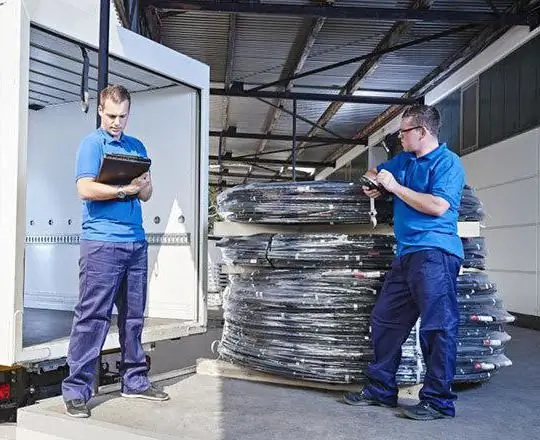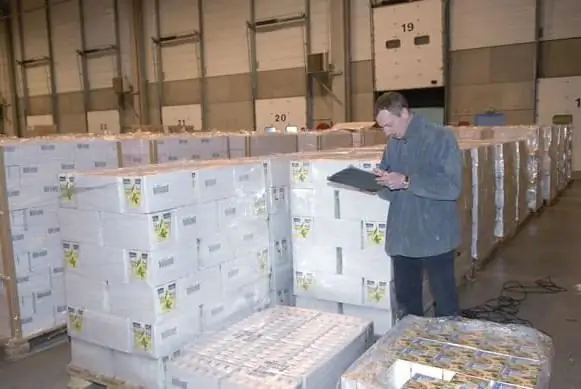2026 Author: Howard Calhoun | [email protected]. Last modified: 2025-01-24 13:10:28
The receipt of goods at the warehouse of a retail trade enterprise is carried out from manufacturers and wholesalers. Accompanying papers are issued for products. In the article, we will consider the features of receiving and accounting for the receipt of goods.

General information
Invoices and invoices are the main documents for the receipt of goods. As a rule, delivery of products to a retail enterprise is carried out by road. In this case, the movement of goods is issued by the TTP (consignment note).
TTP Sections
The waybill consists of transport and commodity parts. The supplier enters the information in the latter. The product section should contain information about:
- to the supplier and payer (names, bank details);
- product and packaging (tare): name, short description, article number, gross weight, number of pieces, type of packaging, amount, price;
- VAT (10% or 18%).
The section is signed by the persons who authorized the delivery, released and accepted the products.
Transport part
This section includes information about:
- delivery date;
- Vehicle number and waybill;
- nameand address of the recipient, sender, customer (payer);
- point of loading / unloading (this information is entered if necessary);
- cargo (number of pieces, short name, weight, type of container).
Receiving at the warehouse
One copy of the TTP upon receipt of goods is received by the storekeeper (merchant manager) from the financially responsible employee of the supplier. After that, a copy of the incoming invoice and accompanying papers issued by the supplier's representative are transferred to the accounting department.
If, upon receipt of the goods, a discrepancy between the information given in the documents and the actual quantity of products is revealed, an act is drawn up. It is signed by both parties.
When accepting, the storekeeper is obliged to check the quality of the products.

Features of accompanying papers
For food raw materials, retail food products, a document must be issued confirming their safety and quality. It should contain a reference to the number of the permit (hygienic certificate) and the date of its issue. This document is drawn up by the authorized bodies of the State Sanitary and Epidemiological Supervision.
In papers for imported products, there must be a mark on passing a hygienic check in the manner prescribed by regulatory enactments.
Sale of food raw materials and food products without the above documents is not allowed.
Check
Upon receipt of the goods, control of its quality, compliance of the actual availability with the information of the accompanying documentation, as well asthe marking indicated on the container is carried out by a financially responsible employee. The check can be carried out not only directly by the storekeeper, but also by the warehouse manager or even the head of the enterprise.
The following should be considered when taking food products:
- Meat should be accepted with a veterinary brand and a document confirming the inspection of the veterinary supervision.
- Poultry must be gutted. An exception is provided for game.
- Accept eggs without a veterinary certificate for each batch, with a damaged shell, contamination on them is not allowed.
- Dairy products must arrive in clean containers and intact packaging.
- Fish (smoked, chilled), products and semi-finished products from it are sent immediately for sale. Storage of these products in the warehouse is not allowed.
- Expired low-alcohol and non-alcoholic drinks, bottled products without labels, damaged corks/lids, sediments and other defects are not allowed.
- Baked goods, bread must be delivered to the warehouse with quality control; the weight of each type of product must comply with the technical conditions and standards.
Capitalization
New arrival of goods is taken into account on the day of shipment to the warehouse according to the actual quantity. If it is not possible to comply with this rule (when checking quality, cost, quantity, calling an expert, etc.), in the text section of the report after the receipt of the receipt, the financially responsible person makes a record in which he indicates the supplier, the total cost of products (inretail prices), the reasons for the impossibility of posting in the prescribed manner.

Individual supplier
Retailers often purchase products from the population in order to expand their assortment. These products are of low cost and high quality.
Purchase is made on the basis of the contract. Relations between the parties to the transaction are regulated by the norms of Ch. 30 GK (par. 1).
A feature of the purchase of goods is that one of the participants is a citizen who does not have the status of an individual entrepreneur, and the other is a legal entity. According to the rules, the agreement between them must be in writing. This form of contract is also necessary for the enterprise to document its costs.
Procurement Act
Upon receipt of goods, the form OP-5 can be issued. This document was approved by the Decree of the State Statistics Committee No. 132 of December 25. 1998 and is intended for catering enterprises. However, according to a number of experts, it is quite possible to use it when legal entities purchase products from the population. The organization, in addition, at its discretion, may develop another document that will draw up a new receipt of goods. In this case, the provisions of the Federal Law No. 129 should be taken into account.
The document, like the TTP, is drawn up in two copies. The first is transferred to an individual, the other is sent to the accounting department.
Important moment
In the form of OP-5, the passport data of the citizen-supplier must be present. This information will subsequently be needed by the company to submit reports onamounts paid to individuals.
Financially responsible workers
At trading enterprises, as a rule, a special employee is appointed to carry out operations to purchase products from the population. He becomes financially responsible by order of the head of the organization and concludes an appropriate agreement with the employer. This requirement is present in clause 7.2 of the Guidelines for accounting and registration of storage, receipt and release of goods in trade organizations.
Responsible employee receives a certain amount of money under the report. He independently makes settlements with individual suppliers.
At the completion of the purchase, the responsible employee provides the accounting department with a report on actual expenses. It is accompanied by a purchase act and a copy of the invoice confirming the transfer of products to the warehouse.

The next advance amount is issued only after the employee has fully accounted for spending the previously issued funds.
Based on the documents provided by the responsible officer to the accounting department, the receipt of goods is reflected in the accounting. Products are accounted for at actual cost. Such a rule is enshrined in paragraph 5 of PBU 5/01.
VAT
As established in the Tax Code, individuals are not VAT payers. Accordingly, products purchased from citizen-suppliers do not contain an "input" tax. This, in turn, determines some features of the sale of such goods.
Tax base for the resale of products,purchased from individuals, is calculated from the difference between the cost of sale and acquisition in accordance with paragraph 4 of paragraph 154 of Article NK.
Receipt of goods and services in "1C"
Reflection of product acceptance operations is carried out by a special document. It is called "Receipt of goods and services".
Meanwhile, the purpose of this document is quite broad. With its help, the acceptance of any goods and materials (inventory, as well as services) is formalized.
It is worth saying that filling out the document "Receipt of goods and services" has some nuances. You need to know them in order to avoid mistakes during registration.
Document entry
The registration of the receipt of goods in "1C: 8.2" must begin with the selection of the "Purchases and sales" section. In the navigation panel, click on the link "Receipt of goods and services". After that, a list of documents entered earlier into the database will open.
Create a new document by pressing the "Add" button.
Some fields in the opened form are underlined in red. Information in them must be entered without fail.
Here is a list of details:
- "Type of operation". This attribute determines the type of receipt of goods. In "1C: 8.3", as in the earlier version, by default, the field is "purchase, commission". Information can be left unchanged.
- "Organization". Information about the company must be present without fail. If information is provided bydefault, then when a new document is generated, it will be substituted in the field automatically. If the application takes into account data for several enterprises, and the receipt of goods in "1C" is not reflected in the main company, the information should be entered manually.
- "Warehouse". This field is optional, if the parameters do not indicate that accounting is performed by warehouses. The third subconto (account 41) will depend on the design of this field in the postings on the product accounting account.
- "Counterparty". The vendor is listed here. It can be selected from the directory. The contract and counterparty can also be entered in advance.
When entering information about the contract directly from the directory, errors often occur when filling in the "type of contract" attribute. Subsequently, the system will not be able to identify the information. If you enter data from the receipt document, the required value will appear in the program automatically. The form of the contract must indicate "with the supplier".

Advance payment
This prop can be selected from the list:
- "automatically";
- "do not read";
- "by document".
Default is first option.
For automatic offset, you need to set up accounting for receipts. For this, the register "Accounts of settlements" is used. The default is set to 60.02. This account will be automatically inserted into the instructions through which the advance payment is made.supplier. In addition, c. 60.02 will be reflected in the "Settlement accounts" tab in the receipt document.
The program will analyze the presence of an advance payment and, if the account balance is found, will generate a posting for the offset.
Table "Products"
It is used to reflect the list of purchased products. Input is carried out using the "Add" and "Selection" buttons. The latter shows information from the reference book "Nomenclature". It greatly simplifies the process of filling in the table.
In the selection form, you can search, request cost and quantity.
After selecting positions, click on the "Transfer to document" button, and they will be transferred to the table automatically.
VAT accounting
The tax rate is filled in automatically from the reference book "Nomenclature". The indicator in the "Price" column does not include VAT.
In the tabular section of the document there are obligatory details "VAT account" and simply "Account account". They can be entered manually. To fill them in automatically, you need to set up the data register "Product accounting accounts".

Price Management
The "Price without VAT" link will redirect to the "Price and currency" tab. From here, the order of filling in price indicators in the document, currency, as well as the order of tax reflection is carried out.
If the price type is specified in the contract of the counterparty, it is determined in the documentautomatically.
If "Price includes VAT" is set, you can enter the cost including tax in the column.
You can change the currency if the contract with the counterparty provides for settlement in it. In this case, you can set the rate and recalculate the price.
If the checkbox is set to "Include VAT in the price", you can not allocate the "input" tax by posting to DB inc. 19, and attribute it to the cost of production. If it is not there, there will be an entry in the postings for dB sch. 19.03.
Supplier invoice: registration
At the bottom of the document form there are fields for entering the date and number of the incoming document. Nearby is the "Register" button. Invoice registration is required for VAT accounting.
Clicking on the above button enters a document called "Invoice Received" with the required information taken from the receipt. If it has already been entered earlier, then a link will appear in the document form (in its lower part). It can be used to open a document.
Additional bookmark
It is used to store the incoming number and date. Here you need to specify the details of the invoice from the supplier. The number and date of the drawn up document do not need to be replaced by the invoice data.
If the sender or recipient of the goods differs from the supplier and the organization receiving the products, in the "Additional" tab in the relevant details, select the appropriate persons.

Synthetic accounting andanalytics
Trading enterprises usually keep records both in the warehouse and in accounting documents. Accountants can only use the synthetic method. At the warehouse, in turn, analytical accounting is maintained.
Last done by:
- legal entities and separate divisions;
- financially responsible employees;
- product range.
Analytics can also be conducted in a context convenient for the enterprise.
Accounting for products is carried out in accordance with the primary documentation only in value terms or both in value and in kind terms. The second option is considered the most appropriate.
At the beginning of the activity, the enterprise must determine the method of storing products: varietal or batch. The accounting method will also depend on this.
Partition method is convenient for organizations implementing:
- medicines;
- food;
- cosmetics and other products with a relatively short shelf life.
The varietal method involves keeping accounting cards or a commodity book. Each individual item and variety has its own page or card.
In accounting, information from warehouse accounting registers may not be duplicated. With the balance (operational-accounting) method, the specialist responsible for the posting of products must periodically check the correctness of the inventory records. Errors must be corrected immediately upon discovery.
On the first day of each month, according to inventory recordsbalance sheet is formed. It indicates the balance of products by price, quantity, names and grades.
Recommended:
Accounting documents are The concept, rules for registration and storage of accounting documents. 402-FZ "On Accounting". Article 9. Primary accounting documents

Proper execution of accounting documentation is very important for the process of generating accounting information and determining tax liabilities. Therefore, it is necessary to treat documents with special care. Specialists of accounting services, representatives of small businesses who keep independent records should know the main requirements for the creation, design, movement, storage of papers
Formation of accounting policy: basics and principles. Accounting policies for accounting purposes

Accounting policies (AP) are specific principles and procedures applied by the company's management for the preparation of financial statements. It differs in certain ways from accounting principles in that the latter are rules, and policies are the way a company adheres to those rules
Tax accounting is The purpose of tax accounting. Tax accounting in the organization

Tax accounting is the activity of summarizing information from primary documentation. The grouping of information is carried out in accordance with the provisions of the Tax Code. Payers independently develop a system by which tax records will be kept
Accounting for working hours in the summary accounting. Summarized accounting of the working time of drivers with a shift schedule. Overtime hours with summarized accounting of wor

The Labor Code provides for work with a summarized accounting of working hours. In practice, not all enterprises use this assumption. As a rule, this is due to certain difficulties in the calculation
Re-sorting of goods is a simultaneous shortage of one item of goods and a surplus of another. Accounting for sorting during inventory

When conducting an inventory at trading enterprises, shortages, surpluses, and regrading are often revealed. With the first two phenomena, everything is more or less clear: there is either a lot of this or that product, or a little. Re-sorting of goods is a rather unpleasant and difficult situation

